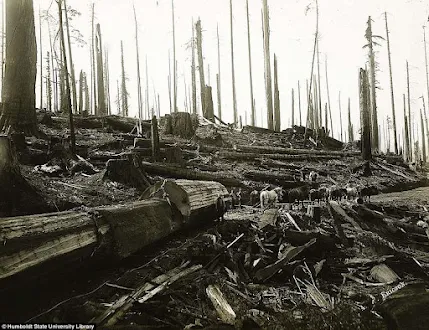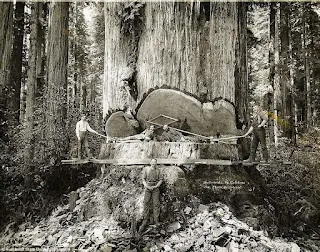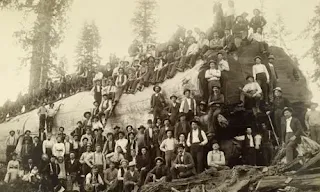Redwoods can grow to be about 9 metres in diameter and more than 76 metres tall. The tallest recorded tree is known as “General Sherman”, found in Sequoia National Park. General Sherman stands at 84 metres tall, has a 31 metre circumference and is estimated to weigh 1.2 million kilograms. Imagine a tree taller than a 25 storey building.
Sequoioideae, popularly known as redwoods, is a subfamily of coniferous trees within the family Cupressaceae. It includes the largest and tallest trees in the world.
Coast redwood trees are the tallest trees on the planet. They can grow to 300 feet high or more, as compared to the tallest pine tree at 268 feet or the tallest tanoak at 162 feet.
Coast redwoods range from southern Oregon to central California, extending not more than fifty miles inland- only as far as the coastal climate has its influence.
Redwoods can live more than 3,000 years, with the oldest tree on record living more than 3,500 years
California's North Coast provides the only such environment in the world. A combination of longitude, climate, and elevation limits the redwoods' range to a few hundred coastal miles. The cool, moist air created by the Pacific Ocean keeps the trees continually damp, even during summer droughts.
From a seed no bigger than one from a tomato, California's coast redwood (Sequoia sempervirens) may grow to a height of 367 feet (112 m) and have a width of 22 feet (7 m) at its base. Imagine a 35-story skyscraper in your city and you have an inkling of the trees' ability to arouse humility.
Some visitors envision dinosaurs rumbling through these forests in bygone eras. It turns out that this is a perfectly natural thought. Fossil records have shown that relatives of today's coast redwoods thrived in the Jurassic Era 160 million years ago. And while the fantastic creatures of that age have long since disappeared, the redwoods continue to thrive, in the right environment.
California's North Coast provides the only such environment in the world. A combination of longitude, climate, and elevation limits the redwoods' range to a few hundred coastal miles. The cool, moist air created by the Pacific Ocean keeps the trees continually damp, even during summer droughts. These conditions have existed for some time, as the redwoods go back 20 million years in their present range.
Growth Factors
Exactly why the redwoods grow so tall is a mystery. Theories continue
to develop but proof remains elusive. The trees can reach ages of 2,000
years and regularly reach 600 years.
ALTHOUGH the giant sequoia and redwood are closely related, they exhibit many individual characteristics that distinguish them from each other. Perhaps the following major differences will help to answer some of the questions that may come to mind.
Natural habitat.—The giant sequoia is found growing singly or in groups scattered for a distance of 250 miles along the western slopes of the Sierra Nevada in central California at elevations of 4,000 to 8,000 feet. The redwood grows near the Pacific Ocean along the northern California coast in a more or less continuous belt about 450 miles long and 15 miles wide. (See Distribution Map on the Inside Back Cover.)
Method of reproduction.—Both species reproduce from seed, but the redwood is one of the few conifers that is also able to develop sprouts from cut stumps, roots, and burls.
Foliage.—The foliage of the giant sequoia is scalelike and somewhat resembles that of the junipers; redwood foliage is in the form of two-ranked needles like the hemlock.
Shape and size.—The giant sequoia is the largest tree in the world in volume and has an immense trunk with very slight taper; the redwood is the world's tallest tree and has a slender trunk.
Cones and seed.—The cones and seed of the giant sequoia are about three times the size of those produced by the redwood.
Woody structure.—The wood of the giant sequoia is much coarser in texture than that of the redwood, and growth rings of the redwood are wider. Both woods are highly resistant to decay.
Color of bark.—The bark of the giant sequoia is bright reddish brown, whereas that of the redwood is a dull chocolate brown.
Parts Most Frequently Used: Leaves, Sap, Inner bark. Fruit is edible.
Flavors/Temps: Bitter, Cooling
Caution: High Tannin content means you want to watch dosing as too much could upset your stomach.
History/Folklore: The Giant Sequioa was named after Chief Sequoia (of the Cherokee Nation). The Sequoia tribe could read and write and had an 86 letter alaphabet. The Pomo indians used these trees for medicine and food. The Cherokee considered Redwoods as a symbol of wisdom, independence and communication. The trees are known as “peace givers” by Native Americans.
The Chinese Redwood was thought to be extinct for thousands of years and then was happily rediscovered in 1944. Redwoods have experienced morphological stasis for the last 65 million years, meaning the modern tree is identical to its late Cretaceous ancestors. The gummy sap is used as a stimulant and tonic to treat fatigue, stress, and rundown conditions. A brown dye can be made from the bark. Sprouts from burls have been used in making baskets. The soft fibrous bark can be easily harvested without hurting the tree and was used as insulating or stuffing material, the fine bark dust created while doing stripping the bark is a good soil conditioner.
The trees are an ancient symbol of protection, balance, and pursuing new visions. Redwoods are practically immune to termites and pests making their wood valuable for building with.
A Redwoods roots never die, when the tree dies or is cut down, new ones grow from the sprouts of the tree’s roots. The only way to stop a redwood from growing is to have it struck by lightening.
Medicinal Use of Redwood
A tea from the needles can be used as an expectorant, and as disinfectant for urinary tract infections. A poultice of the bark was used as a treatment for venereal diseases. A tincture of the inner bark was taken to purify the blood.
A poultice of the heated leaves has been used in the treatment of earaches. The gummy sap has been used as a stimulant and tonic in the treatment of rundown conditions.
Tea
When you make a tea of the fresh, green needles of a redwood tree, you are drinking in all those qualities of the tree – allowing them to flow through your body and permeate your being. Calling in strength, endurance, connection, and community.
Propagation of the redwood tree
Redwoods are monoecious, meaning both male (pollen-producing) and female (seed-bearing) cones are borne on the same tree but on different branches. The pollen is shed in winter or in spring, whereas the mature, fertilized ovulate cones ripen in early fall to shed their seeds in late fall and early winter. Cones are only produced after they reach the canopy and can use direct sunlight for energy. Redwood cones are only about one inch long. Each cone holds between 14 and 24 seeds. The seeds are so tiny that you would need over 100,000 seeds to weigh one pound! Redwoods start to bear their seeds when they are about five to fifteen years old. The cones dry under conditions of low humidity and release their seeds. Rains normally speed up seed dispersal. The seeds are normally ready to germinate soon after they have fallen to the ground, as long as the soil is moist and the weather is warm enough. Studies have shown that seed viability increases with the age of parent trees. Maximum seed viability was reached when trees were over the age of 250 years. On the other hand, seeds produced by trees under twenty years old were less than one percent viable. One tree can produce six million seeds in one year. However, less than 5% of these seeds germinate, and only a few of these end up growing into seedlings. Failure usually results from parasitic fungi, summer drought, or other causes
New redwood trees can come about in four ways: through seeds, cuttings, stump sprouts, and root sprouts. QUEST on KQED Public Media. Like all plants, redwoods can grow from seeds. Redwood seeds come from those tiny, inch-long redwood cones that fall from the branches in autumn.Cultivation of Coastal Redwood:
Deep well-drained soils on flat land and slopes in the coastal fog belt below 600 metres.
- Soak redwood seeds in a glass of water overnight to speed germination. ...
- Fill a container with potting soil. ...
- Spread the redwood seeds on the surface of the soil. ...
- Place the container in full sunlight or partial shade.
- Keep the redwood seeds moist, but not wet, at all times.
Redwoods grow very quickly in full sunlight, often 18 inches in the first year, and 2 to 6 feet a year for the first 10 years.
It can also grow faster than associated species in deep shade. Redwood
is often found growing with Douglas-fir which can grow as quickly as
redwood on many sites.
These Trees Help Protect us from Climate Change
Trees are critically important in maintaining a stable climate here on earth. Studies show that Redwoods capture at least three times more carbon dioxide (CO2) from our global emissions (from cars, trucks, power plants etc) than any other tree on the planet. So by protecting our local Redwoods we are ensuring we help stabilize our global climate.
They Can Adapt for Earthquakes
Many well-known Redwood forests across the United States and in New Zealand are found in regions know for earthquakes. However the shifting earth causes no trouble for these giants. Where a Redwood has been forced to lean due to circumstances like shifting earth, flooding or other trees that have fallen against them, they can accelerate their growth on the downhill side in order to stabilise themselves and avoid toppling over.
Destruction of the North American Forests by Europeans
On Monday, 27 June, 1853, a giant sequoia – one of the natural world's most awe-inspiring sights - was brought to the ground by a band of gold-rush speculators in Calaveras county, California. It had taken the men three weeks to cut through the base of the 300ft-tall, 1,244-year-old tree, but finally it fell to the forest floor.
A section of the bark from the "Mammoth Tree", as newspapers soon described it, had already been removed and was sent to San Francisco to be put on display. The species had only been "discovered" (local Native American tribes such as the Miwok had known of the trees for centuries) that spring by a hunter who stumbled upon the pristine grove in the foothills of the Sierra Nevada whilst chasing an injured bear. Word of the discovery quickly spread.
In the age of PT Barnum's freak shows, the speculators, mostly gold miners, had sensed a commercial opportunity. The section of bark – re-erected using scaffold, with a piano inside to entertain paying visitors - would later be sent to Broadway in New York, as would the bark from a second tree felled a year later. The bark of the "Mother of the Forest" – as the second tree was named – would even go on to be displayed at London's Crystal Palace causing great excitement and wonder in Victorian England before it was destroyed by fire on 30 December 1866. (The bark of the original mammoth tree was also lost to fire as it lay in storage in New York in 1855. A fitting end, perhaps, as fire plays such a crucial role in the life cycle of giant sequoias.)
The fame of the trees was such that a hotel was quickly built at the site to host the influx of tourists. To entertain the guests, tea dances were regularly held on the stump of the mammoth tree and a bowling alley was built on the now prone trunk.
According to Gary D Lowe, a local historian, author and "Big Tree" aficionado, the first-known negative commentary came a month before the tree was felled. An article in the Sonora Herald, a local newspaper, reported that Captain Hanford, the man leading the enterprise, "is about stripping off the bark". The report went on: "This will of course kill the tree, which is much to be deprecated."
On 27 June, 1853 – the same day the tree finally fell - a report in San Francisco's Placer Times and Transcript also noted an article, again in the Sonora Herald, expressing regret that Captain Hanford was preparing for a "portion of the mammoth tree" to be sent to New York.
"Amator" [Latin for "friend"] is dreadfully shocked at the vandalism and barbarity of flaying that giant of the woods, and depriving California of its greatest "growing" exponent.
But these were reports in local newspapers with little influence outside the communities they served. A far more significant report came that autumn when Maturin M Ballou, the Boston-based editor of Gleason's Pictorial Drawing Room Companion, one of the most widely read magazines of the day, printed an illustration of the "largest tree yet discovered in the world" on 1 October, 1853. The accompanying text said:
To our mind it seems a cruel idea, a perfect desecration, to cut down such a splendid tree…In Europe, such a natural production would have been cherished and protected, if necessary, by law; but in this money-making, go-ahead community, thirty or forty thousand dollars are paid for it, and the purchaser chops it down, and ships it off for a shilling show! We hope that no one will conceive the idea of purchasing the Niagara Falls with the same purpose!...But, seriously, what in the world could have possessed any mortal to embark in such speculation with this mountain of wood? In its natural condition, rearing its majestic head towards heaven, and waving in all its native vigour, strength and verdure, it was a sight worth a pilgrimage to see; but now, alas, It is only a monument of the cupidity of those who have destroyed all there was of interest connected with it.
Five months later, on 11 March, 1854, Ballou printed a further remark in his magazine:
A tree of such gigantic proportions as well might excite the wonder and curiosity of the world. Although the destruction of such a magnificent object was an act of vandalism not to be forgiven, yet the desecration has been committed, and it is useless now to reiterate our vain regrets.
However, the ripples of outrage took a further year – and the stripping of the Mother of the Forest – to really gain traction. Then came this editorial in the New York Herald, dated 17 December, 1855:
The finest, the most beautiful and symmetrical of these trees, (though not the largest) has been cut down…From this beginning, unless the Goths and Vandals are arrested in their work, the destruction of the incomparable forest will probably go on till the last vestige of it is destroyed. In this view, the point that we make is, that the State of California and the Congress of the Union should interpose to preserve these trees, as the living proofs that the boasted monarchs of the wood of the Old World are but stunted shrubbery compared with the forest giants of our own country. We say that Congress should interpose, upon the presumption that these trees are public property, are on the public lands of California, and because Congress has already interposed to protect the public live oak forests of Florida from the rapacity of unscrupulous speculators…We repeat, that it is the duty of the State of California, of Congress, and of all good citizens, to protect and to preserve these California monuments of the capabilities of our American soil. Let it be the law that this…Mammoth Grove shall stand.
Some scientists question whether controlled burns and logging are really the best way to preserve California’s iconic redwoods
https://www.scientificamerican.com/article/to-save-the-redwoods-scientists-debate-burning-and-logging/
My question is: are they scientists or vandals bribed by some crazy people?
Prescribed burning has been practiced in the giant sequoia forests since the 1960s, when the ecologist Harold H. Biswell began studying fuel reduction in redwood stands near Sequoia National Park, earning himself the nickname “Harry the Torch.” Two decades later, when the Pierce Fire moved through Sequoia National Forest, it burned old-growth trees. But when the blaze entered the Redwood Mountain giant sequoia grove—a part of the park that had been subject to a controlled burn a few years prior—it became less intense and crews were able to contain it.
That is what the uncivilized world is doing to the environment.














No comments:
Post a Comment